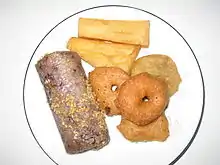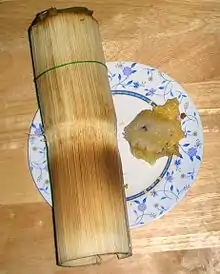Sticky rice in bamboo
Sticky rice in bamboo is a common Southeast Asian dish consisting of sticky rice roasted inside specially prepared bamboo sections of different diameters and lengths. It is consumed both as a savory food and as a sweet dessert.
 Burmese paung din | |
| Place of origin | Cambodia, Laos, Myanmar (Burma), Thailand |
|---|---|
| Region or state | Southeast Asia |
| Associated national cuisine | Burmese, Cambodian, Lao, Thai |
| Main ingredients | Glutinous rice, hollow bamboo tubes |
| Similar dishes | Lemang, Daetong-bap |
Names
The dish is known by various names throughout Southeast Asia, including paung din (ပေါင်းတင်း) or kauk hnyin kyi dauk (ကောက်ညှင်းကျည်တောက်) in Burmese, kralan (Khmer: ក្រឡាន) in Khmer, and khao lam (Thai: ข้าวหลาม, pronounced [kʰâw lǎːm]; Lao: ເຂົ້າຫລາມ) in Lao and Thai. In Thai, khao means rice and lam means the cooking process, which involves roasting the contents in prepared bamboo sections.
In Malaysia and Indonesia, it known as lemang, which is typically eaten during Eidul Fitri celebrations, where it can be eaten with rendang.
Variations
Cambodia

In Cambodia, kralan cake is often made and eaten at Chinese New Year and Khmer New Year. Thma Krae village in Kratie Province has become well known for its kralan.[1]
Myanmar (Burma)

Paung din (ပေါင်းတင်း) or kaukhnyin kyidauk (ကောက်ညှင်းကျည်တောက်) is another ready-to-eat portable form cooked in a segment of bamboo. When the bamboo is peeled off, a thin skin remains around the rice, and it also gives off a distinctive aroma.
Thailand

Khao lam uses sticky rice with red beans, sugar, grated coconut, and coconut milk roasted in It can be prepared with white or dark purple (khao niao dam) varieties of glutinous rice. Sometimes described as a "cake", thick khao lam containers may have a filling of coconut custard in the center that is made from coconut cream, egg, and sugar. Khao lam can be consumed as savory food or dessert. It is a cultural food and is an OTOP[2] product . Moreover, Thai people present khao lam to monks to make merit. Further, it is gradually becoming a Thai tradition.
In the past, Thailand had innumerable bamboo trees. Thai people thought about the utility of using bamboo for cooking purposes. The ingredients of khao lam are glutinous rice, black beans, coconut milk, sugar and salt.[3] Moreover, taro or young coconut may be added.
See also
References
- Nhem, Chea Bunly (May 22–23, 2004). "Let Them Eat Cake". The Cambodia Daily. Archived from the original on 2007-08-29. Retrieved 2009-01-11.
- ""ข้าวหลามปลาร้า" แซบสไตล์อีสาน สูตรเด็ดแม่แอ๊ด โอทอปนครปฐม". ASTV ผู้จัดการออนไลน์. Retrieved 2015-05-17.
- "ข้าวหลาม อาหารจากภูมิปัญญาไทย". Sukhothai Thammathirat Open University. Retrieved 2015-05-17.